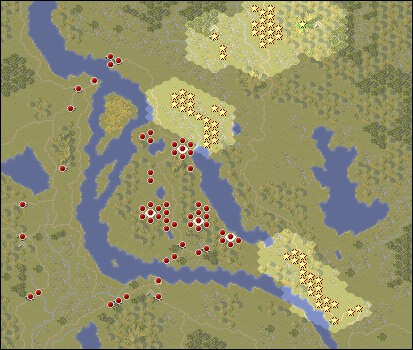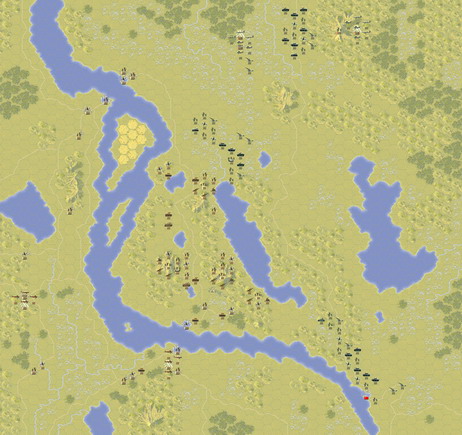 When you move the mouse pointer over the map, unit name, strength and coordinates are displayed as a label. When you press terrain button object name is displayed (city, river, sea, ...) |
Khasan
29.7.1938 - 11.8.1938
PacPG: 2.8.1938 - 10.8.1938
Scenario Map:
|
|
|
Changes and corrections of map:
|
Scenario author: Scenario origin: Last revision date: |
stanny 6.7.2005 11.8.2008 |
First release: Revision released: |
4.8.2009 ( Release 01 ) 20.11.2009 ( Release 01 Revision 02 ) |
| Completely new scenario. Soviet-Japanese border conflict in the east Manchuria. |
Historic overview:
| Known song of the Soviet Far Eastern border guard indicates the place where they tested the Japanese Kwantung Army forces and the readiness of the Red Army. Japanese selection test fighting skills Kwantung Army was done very carefully. It was mainly that the reasons for the initiation of combat operations for both its way justified. And throughout human history have such reasons as border issues and the determination of the border ... (Josef Novotný - Kantó Gun - Historie Kuantungské armády, Fontána 2003) Article on Czech Wikipedia Article on English Wikipedia
| |||||||||||||||||||||||||
Game play matters:
| Campaign play: First scenario the Russian campaign. Lose means end of the campaign. Both Major and Minor victories leads to scenario Halha river. |
Scenario data:
|
Map size: 52 x 43 hexes 18 turns, 2 turns per day Version: PacAGPG 2, Starting side: Allies, Campaign: Russian campaign, Order in campaign: 1. |
||||||||
|
||||||||
|
||||||||
|
||||||||
|
||||||||
|
Game time costingness of scenario: 27.23 % (product of units and turns numbers divided by difference between the most long and the most short scenario) |
||||||||
|
Number of Allied units: 69 units, from them are 11 core units and 58 auxiliary units 12 air units, 0 naval units and 57 ground units 0 of units are loaded to air transport and 0 to naval transport |
Transports Air/Naval: Allies - Axis 1/6 - 0/6 |
|||||||
|
Number of Axis units: 68 units 8 air units, 0 naval units and 60 ground units 0 of units are loaded to air transport and 0 to naval transport |
Initial prestige + every turn donation: Allies / Axis 400 + 0 / 340 + 70 |
|||||||
|
Max number of Allied units: 72 units, from them are 12 core units and 60 auxiliary units - on start of scenario is possible to purchase 3 unit (1 core + 2 auxiliary) |
||||||||
|
Max number of Axis units: 70 units - on start of scenario is possible to purchase 2 unit |
||||||||
Transport units:
|
||||||||
|
| Allied units: Saperi (USSR) Strelki 1938 (USSR) Kavalerija (USSR) ST OT-130 (USSR) ST BT-7 (USSR) ST T-38 (USSR) ST BT-5 (USSR) ST T-26 (USSR) ST BA-10 (USSR) ST BA-20 (USSR) ST BA-6 (USSR) ST 12.2cm Gun (USSR) ST 7.62cm Gun (USSR) ST I-15 (USSR) ST Tupolev TB-3 (USSR) ST Truck (USSR) |
Axis units: Senpaku Kohei (Engineers - SNLF) (Japan) Kihei (Cavalry) (Japan) Kohei (Bridge Engineers) (Japan) Kyoka Hohei 1936 (Infantry HW 1936) (Japan) Hohei 1936 (Infantry 1936) (Japan) Type 95 Ha-Go (Japan) Type 89 Chi-Ro (Japan) Type 92 Jyu-Sokosha (Japan) Type 96 150mm (Japan) Type 94 75mm (Japan) Type 92 70mm (Japan) Type 98 20mm (Japan) Ki-10 Perry (Japan) Ki-32 Mary (Japan) Isuzu Type 94 6-Wheeled Truck (Japan) |
The same time period scenarios:
| Central China (PacPG 1) |
| Airfield Bezimyannaya Bogomolnaja Cicidun Eagle Elevation 194 Ferry Chyornaya Kocha Ku-tiang Display all mapnames in list... |
Tactical map (large & detail):

|
|
|
|
Basic map |
|
|
Map with unloaded transports and order numbers of units |
Battlefield map:

|
|